新课改单元整体教学设计人教版七年级上册Unit 6 Do you like bananas?(表格式 4课时)
文档属性
| 名称 | 新课改单元整体教学设计人教版七年级上册Unit 6 Do you like bananas?(表格式 4课时) |
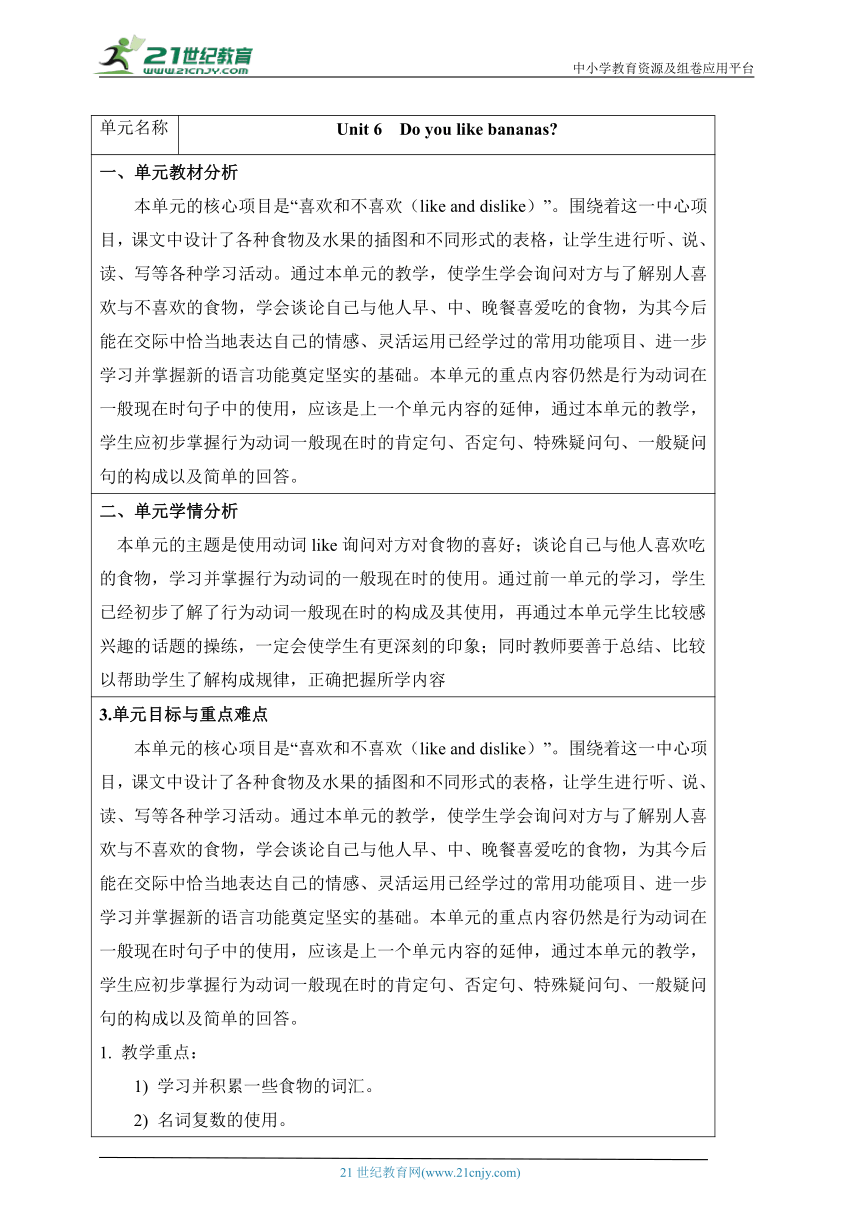
|
|
| 格式 | docx | ||
| 文件大小 | 81.0KB | ||
| 资源类型 | 试卷 | ||
| 版本资源 | 人教新目标(Go for it)版 | ||
| 科目 | 英语 | ||
| 更新时间 | 2023-12-21 14:31:35 | ||
图片预览

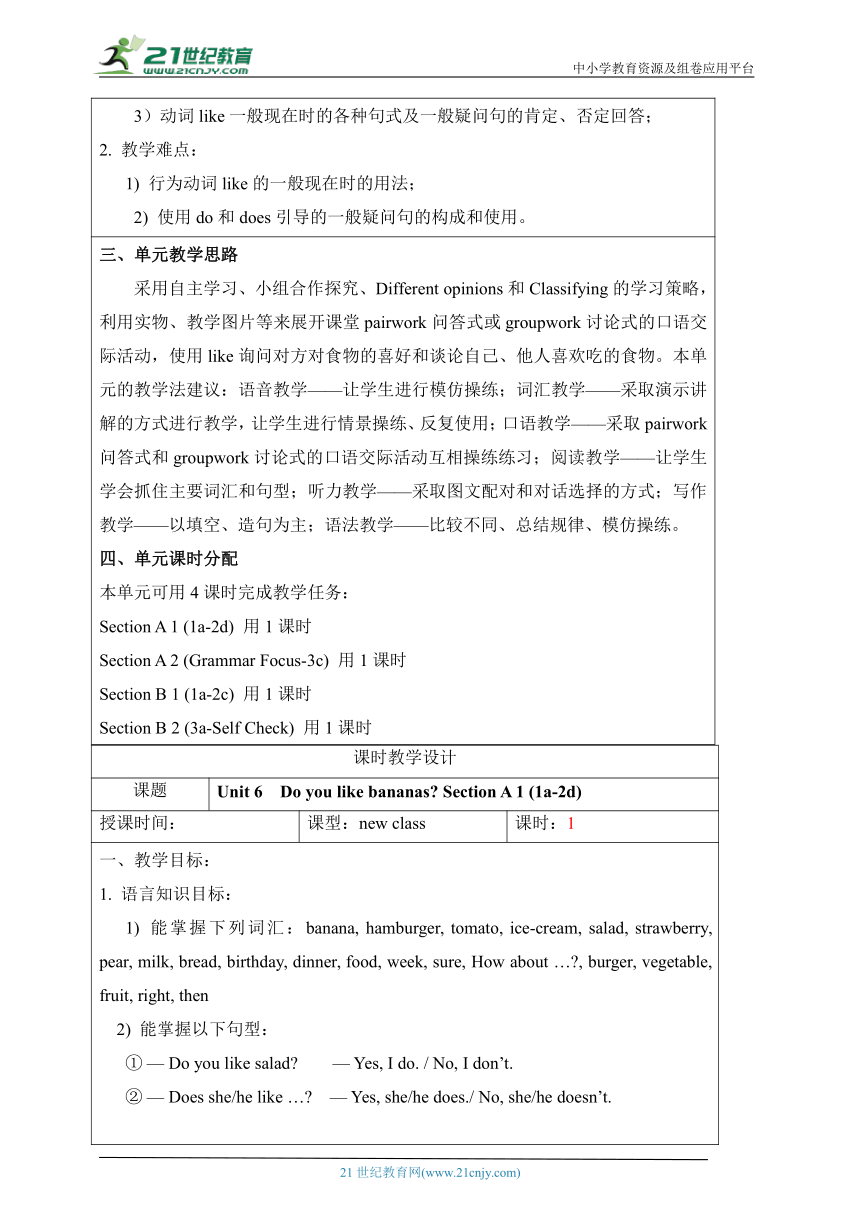
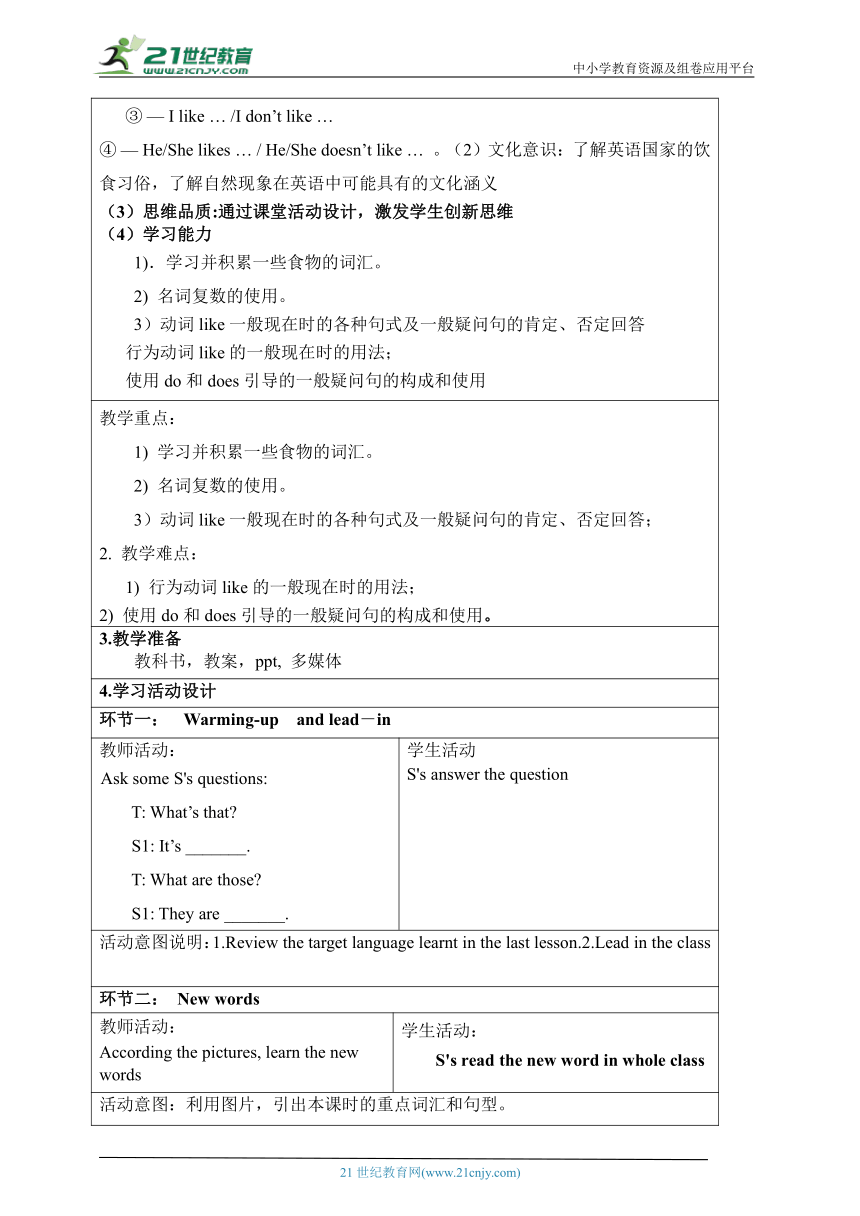
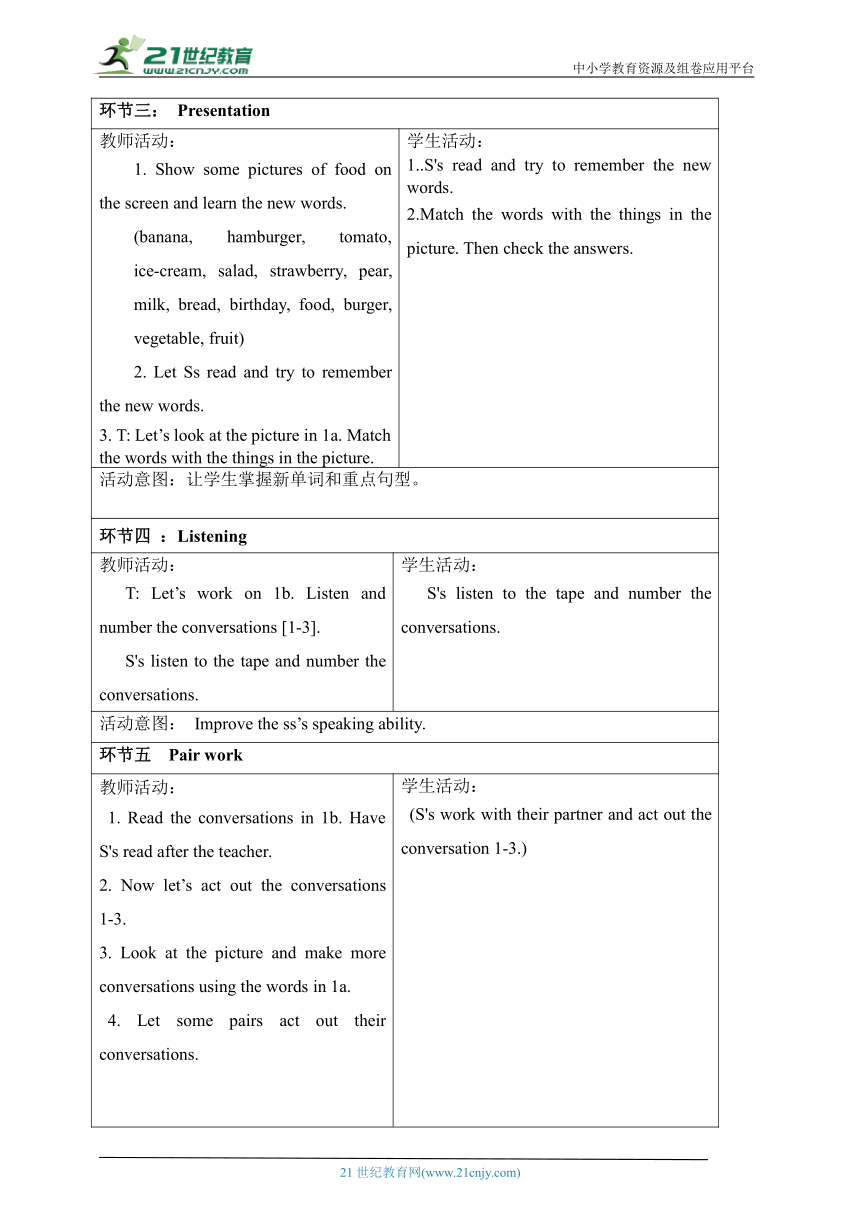
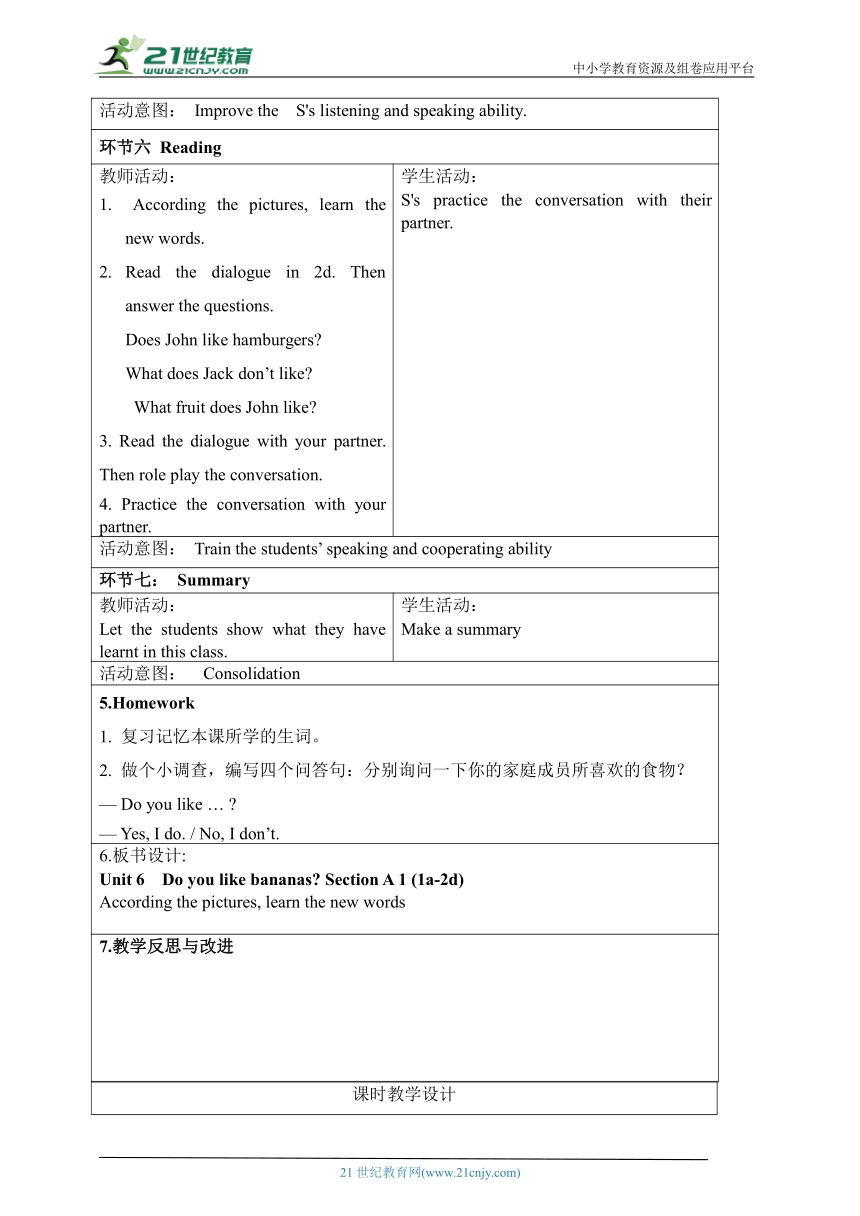
文档简介
中小学教育资源及组卷应用平台
单元名称 Unit 6 Do you like bananas
一、单元教材分析 本单元的核心项目是“喜欢和不喜欢(like and dislike)”。围绕着这一中心项目,课文中设计了各种食物及水果的插图和不同形式的表格,让学生进行听、说、读、写等各种学习活动。通过本单元的教学,使学生学会询问对方与了解别人喜欢与不喜欢的食物,学会谈论自己与他人早、中、晚餐喜爱吃的食物,为其今后能在交际中恰当地表达自己的情感、灵活运用已经学过的常用功能项目、进一步学习并掌握新的语言功能奠定坚实的基础。本单元的重点内容仍然是行为动词在一般现在时句子中的使用,应该是上一个单元内容的延伸,通过本单元的教学,学生应初步掌握行为动词一般现在时的肯定句、否定句、特殊疑问句、一般疑问句的构成以及简单的回答。
二、单元学情分析 本单元的主题是使用动词like询问对方对食物的喜好;谈论自己与他人喜欢吃的食物,学习并掌握行为动词的一般现在时的使用。通过前一单元的学习,学生已经初步了解了行为动词一般现在时的构成及其使用,再通过本单元学生比较感兴趣的话题的操练,一定会使学生有更深刻的印象;同时教师要善于总结、比较以帮助学生了解构成规律,正确把握所学内容
3.单元目标与重点难点 本单元的核心项目是“喜欢和不喜欢(like and dislike)”。围绕着这一中心项目,课文中设计了各种食物及水果的插图和不同形式的表格,让学生进行听、说、读、写等各种学习活动。通过本单元的教学,使学生学会询问对方与了解别人喜欢与不喜欢的食物,学会谈论自己与他人早、中、晚餐喜爱吃的食物,为其今后能在交际中恰当地表达自己的情感、灵活运用已经学过的常用功能项目、进一步学习并掌握新的语言功能奠定坚实的基础。本单元的重点内容仍然是行为动词在一般现在时句子中的使用,应该是上一个单元内容的延伸,通过本单元的教学,学生应初步掌握行为动词一般现在时的肯定句、否定句、特殊疑问句、一般疑问句的构成以及简单的回答。 1. 教学重点: 1) 学习并积累一些食物的词汇。 2) 名词复数的使用。 3)动词like一般现在时的各种句式及一般疑问句的肯定、否定回答; 2. 教学难点: 1) 行为动词like的一般现在时的用法; 2) 使用do和does引导的一般疑问句的构成和使用。
三、单元教学思路 采用自主学习、小组合作探究、Different opinions和Classifying的学习策略,利用实物、教学图片等来展开课堂pairwork问答式或groupwork讨论式的口语交际活动,使用like询问对方对食物的喜好和谈论自己、他人喜欢吃的食物。本单元的教学法建议:语音教学——让学生进行模仿操练;词汇教学——采取演示讲解的方式进行教学,让学生进行情景操练、反复使用;口语教学——采取pairwork问答式和groupwork讨论式的口语交际活动互相操练练习;阅读教学——让学生学会抓住主要词汇和句型;听力教学——采取图文配对和对话选择的方式;写作教学——以填空、造句为主;语法教学——比较不同、总结规律、模仿操练。 四、单元课时分配 本单元可用4课时完成教学任务: Section A 1 (1a-2d) 用1课时 Section A 2 (Grammar Focus-3c) 用1课时 Section B 1 (1a-2c) 用1课时 Section B 2 (3a-Self Check) 用1课时
课时教学设计
课题 Unit 6 Do you like bananas Section A 1 (1a-2d)
授课时间: 课型:new class 课时:1
一、教学目标: 1. 语言知识目标: 1) 能掌握下列词汇:banana, hamburger, tomato, ice-cream, salad, strawberry, pear, milk, bread, birthday, dinner, food, week, sure, How about … , burger, vegetable, fruit, right, then 2) 能掌握以下句型: ① — Do you like salad — Yes, I do. / No, I don’t. ② — Does she/he like … — Yes, she/he does./ No, she/he doesn’t. ③ — I like … /I don’t like … ④ — He/She likes … / He/She doesn’t like … 。(2)文化意识:了解英语国家的饮食习俗,了解自然现象在英语中可能具有的文化涵义 (3)思维品质:通过课堂活动设计,激发学生创新思维 (4)学习能力 1).学习并积累一些食物的词汇。 2) 名词复数的使用。 3)动词like一般现在时的各种句式及一般疑问句的肯定、否定回答 行为动词like的一般现在时的用法; 使用do和does引导的一般疑问句的构成和使用
教学重点: 1) 学习并积累一些食物的词汇。 2) 名词复数的使用。 3)动词like一般现在时的各种句式及一般疑问句的肯定、否定回答; 2. 教学难点: 1) 行为动词like的一般现在时的用法; 2) 使用do和does引导的一般疑问句的构成和使用。
3.教学准备 教科书,教案,ppt, 多媒体
4.学习活动设计
环节一: Warming-up and lead-in
教师活动: Ask some S's questions: T: What’s that S1: It’s _______. T: What are those S1: They are _______. 学生活动 S's answer the question
活动意图说明:1.Review the target language learnt in the last lesson.2.Lead in the class
环节二: New words
教师活动: According the pictures, learn the new words 学生活动: S's read the new word in whole class
活动意图:利用图片,引出本课时的重点词汇和句型。
环节三: Presentation
教师活动: 1. Show some pictures of food on the screen and learn the new words. (banana, hamburger, tomato, ice-cream, salad, strawberry, pear, milk, bread, birthday, food, burger, vegetable, fruit) 2. Let Ss read and try to remember the new words. 3. T: Let’s look at the picture in 1a. Match the words with the things in the picture. 学生活动: 1..S's read and try to remember the new words. 2.Match the words with the things in the picture. Then check the answers.
活动意图:让学生掌握新单词和重点句型。
环节四 :Listening
教师活动: T: Let’s work on 1b. Listen and number the conversations [1-3]. S's listen to the tape and number the conversations. 学生活动: S's listen to the tape and number the conversations.
活动意图: Improve the ss’s speaking ability.
环节五 Pair work
教师活动: 1. Read the conversations in 1b. Have S's read after the teacher. 2. Now let’s act out the conversations 1-3. 3. Look at the picture and make more conversations using the words in 1a. 4. Let some pairs act out their conversations. 学生活动: (S's work with their partner and act out the conversation 1-3.)
活动意图: Improve the S's listening and speaking ability.
环节六 Reading
教师活动: According the pictures, learn the new words. Read the dialogue in 2d. Then answer the questions. Does John like hamburgers What does Jack don’t like What fruit does John like 3. Read the dialogue with your partner. Then role play the conversation. 4. Practice the conversation with your partner. 学生活动: S's practice the conversation with their partner.
活动意图: Train the students’ speaking and cooperating ability
环节七: Summary
教师活动: Let the students show what they have learnt in this class. 学生活动: Make a summary
活动意图: Consolidation
5.Homework 1. 复习记忆本课所学的生词。 2. 做个小调查,编写四个问答句:分别询问一下你的家庭成员所喜欢的食物? — Do you like … — Yes, I do. / No, I don’t.
6.板书设计: Unit 6 Do you like bananas Section A 1 (1a-2d) According the pictures, learn the new words
7.教学反思与改进
课时教学设计
课题 Unit 6 Do you like bananas Section A 2 (Grammar Focus-3c)
授课时间: 课型:new class 课时:1
一、教学目标: 1. 语言知识目标: 1) 继续学习描述自己或他人喜欢或不喜欢的食物,能够用but来表达简单的句子。 2)总结动词like一般现在时的肯定句式、否定句式及一般疑问句的肯定、否定回答。 3) 总结复习可数名词复数的知识。 4)理解英语可数名词与不可数名词的概念,并对所学过的部分词汇按此分类进行归纳总结。 2. 情感态度价值观目标: 二、教学重难点 1. 教学重点: (2)文化意识:了解常见植物在英语国家中的文化涵义(3)思维品质:通过课堂活动设计,激发学生创新、逻辑、发散思维。 (4)学习能力 1.可数名词和不可数名词的变化规则 总结动词like一般现在时的肯定句式、否定句式及一般疑问句的肯定、否定回答。
2.学习重点难点 教学重点: 1)总结动词like一般现在时的肯定句式、否定句式及一般疑问句的肯定、否定回答。 2)理解英语可数名词与不可数名词的概念,并对所学过的部分词汇按此分类进行归纳总结。 2. 教学难点: 理解英语可数名词与不可数名词的概念,并对所学过的部分词汇按此分类进行归纳总结。
3.教学准备 教科书,教案,ppt, 多媒体
4.学习活动设计
环节一: Revision and lead-in
教师活动: T:Review the new words about food, fruit and vegetables. pear (复数) tomato (复数) strawberry (复数) banana (复数) 生日晚宴 下一周 考虑 听起来不错 怎么样? 让我们吃汉堡和一些水果吧 Ask and answer Do you like … Yes, I do. / No, I don’t. Let’s have …. Sounds good. /No, I don’t like ___. (Exchanging the roles ask and answer questions.) 学生活动 S's look at the picture in 1a and finish it
活动意图说明:Review the target language learnt in the last lesson.
环节二: II. Grammar Focus
教师活动: 一、单元句式结构阅读指导: 1. 行为动词like的各种句式的构成 肯定句: ① 第一人称/第二人称/第三人称复数 + like + 其他 ② 第三人称单数及其他单数名词 + likes + 其他 否定句: ① 第一人称/第二人称/第三人称复数 + don’t + like + 其他 ② 第三人称单数及其他单数名词 + don’t + likes + 其他 一般疑问句: ① Do + 第一人称/第二人称/第三人称复数 + like +其他 回答:Yes, I/we/you/they do. No, I/we/you/they don’t. ② Does + 第三人称单数及其他单数名词 + like + 其他 回答:Yes, he/she/it does. No, he/she/it doesn’t 学生活动: Take notes and master the sentence structure .
活动意图: Help the SS to consolidate the target language master the Grammar focus .
环节三 : Grammar Focus2
教师活动: 可数名词与不可数名词学习指导: 可数名词与不可数名词的含义与特点 定义:不可数名词 指不可以直接计数的名词,它只有单数形式。 特点:不可以与a、an或数词连用,要表示数量的多少时,其前可以加some, any或表数量的词语。如: some bread 一些面包 a cup of milk 一杯牛奶 可数名词:指可以用来计数的名词,它有单数和复数两种形式。可以用a、an或具体的数词修饰。如: a tomato 一个西红柿 an egg 一个鸡蛋 学生活动: S's take note
活动意图: Consolidate the sentence structure.
环节四 III. Practice
教师活动: 1. Let’s work on 3a. Here are some sentences. Please underline the correct words in the brackets. 学生活动: 1.Do it by themselves. 2.Practice and act.
活动意图: Improve the ss’s speaking and cooperating ability.
环节五 Practice
教师活动: 1. Look at the sentences in 3b. Number the sentences [1-4] to make a conversation. So, let’s get salad. Yes, I do. Do you like salad OK. A: Do you like salad B: Yes, I do. C: So, let’s get salad. D: OK. 学生活动: 1.Complete the conversation one by one. 2.Practice and act.
活动意图: Train the students’ speaking and cooperating ability.
环节六: VI. Pair work
教师活动: Ask your classmates about the food in the chart. Find out what they like and don’t like. Do you like ice-cream, Liu Li Yes, I do. Do you like ice-cream, Zhang Jun No, I don’t. 学生活动: Students practice it each other
活动意图: let students do some practice to check their learning outcome.
环节七: VII. Exercises
教师活动: 一、用所给单词的适当形式填空。 1. I like _________ (tomato) very much. 2. Nick _____ (like) hamburgers and salad. 3. Let’s ______ (think) about the birthday dinner. 4. Ms Smith has ten ____________ (strawberry). 5. Hamburgers That ________ (sound) good. 6. My brother __________ (not like) eggs. 7. His cousins ________ (not like) ice-cream. 学生活动: S's finish it .
活动意图: Consolidation
5.作业设计VIII. Homework Talk about your family’s favorite food, write a short passage. 谈论你家人最喜爱的食物,写一段小短文。 My name is…, I like…, but I don’t like… My father likes…, but he doesn’t like… My mother likes…, but she doesn’t like… 2. Review the Grammar Focus.
6.板书设计(板书完整呈现教与学活动的过程,最好能呈现建构知识结构与思维发展的路径与关键点) Unit 6 Do you like bananas Section A 1 (1a-2d)1. some bread 一些面包 a cup of milk 一杯牛奶 a tomato 一个西红柿 an egg 一个鸡蛋
7.教学反思与改进
课时教学设计
课题 Unit 6 Do you like bananas Section A 2 (Grammar Focus-3c)
授课时间: 课型:new class 课时:3
一、教学目标: 1. 语言知识目标: 1) 继续学习有关膳食名词:breakfast,lunch,dinner,egg,apple,chicken,fruit,vegetables;并能按食品、水果和蔬菜进行分类总结。 2)理解可数名词与不可数名词的概念,并能对所学的词汇进行分辨。 3)就食物的话题开展听、说、读、写技能的训练,促进学生语言运用能力的提高。 (2)文化意识:学生能够了解常见植物在英语国家中的文化涵义。 (3)思维品质:通过课堂活动设计,激发学生创新、逻辑、发散思维。 (4)学习能力: 1.继续学习运用有关食物的词汇并能按食品、水果和蔬菜进行分类总结。 2)就食物的话题开展听、说、读、写技能的训练,促进学生语言运用能力的提高。
1)继续学习运用有关食物的词汇并能按食品、水果和蔬菜进行分类总结。 2)就食物的话题开展听、说、读、写技能的训练,促进学生语言运用能力的提高。 2. 教学难点: 阅读有关饮食方面的材料,并能获得相关信息,提高综合运用英语的能力。。
3.教学准备 教科书,教案,ppt, 多媒体
4.学习活动设计
环节一: Revision and lead-in
教师活动: 1. Review the words on food. And list them into countable nouns, uncountable nouns, countable and uncountable nouns. Countable nouns: hamburgers, eggs, oranges, bananas, apples, pear, carrots, vegetables, strawberries Uncountable nouns: milk, bread, rice Uncountable and countable nouns: food, fruit, ice-cream, salad, chicken 学生活动 2. Ss read and try to remember the new words. 3. Review the plural forms of countable nouns.
活动意图说明:复习可数和不可数名词规则及用法,导入新课
环节二: II. Presentation
教师活动: 1. T: How many meals do you have every day Ss: Three. T: What are they (The students can answer them in Chinese.) Ss: They are “早餐、中餐和晚餐”. T: Oh, yes. In English “早餐”we can say “breakfast”. (Show a picture of the breakfast) Read after me, “breakfast”. B-R-E-A-K-F-A-S-T, breakfast. 学生活动: Let S's answer the question S's read and try to remember the new words.
活动意图: 系。
环节三 : III. Writing
教师活动: 1. T: Look at 1a, read the words in the box, then write the number in the box next to the correct food. (The students finish off 1a.) T: Look at 1b. How many other food words can you add to the chart Try to write them down in the chart. 学生活动: The students write them down as soon as possible and then read them. See who will add most.)
活动意图:Help the ss to master the target language and improve their writing ability.
环节四 Ⅳ. Listening
教师活动: 1. T: Look! There are so many foods. Maybe they are very delicious. Which food do you like Do you like tomatoes (Show the picture.) S1: … T: How about chicken Do you like it S1: … T: Can you guess what food I like S1: Do you like … T: No, I don’t. S2: Do you like … S3: Do you like … T: Yes, you are right. I think you are very lucky. But I have two friends. They are Sally and Tom. Do you know what food they like Now, let’s listen and circle the food you hear in 1a. 学生活动: The students find out each food mentioned in the conversation on the recording. Then check the answers..
活动意图: Improve the S's listening ability.
环节五 Ⅴ. Pair work
教师活动: 1. T: Does Tom like tomatoes Ss: Yes, he does. T: Ask and answer about the chart in pairs. Let some Ss act out their conversation. Which food do you think is healthy Check (√) Yes, Maybe or No. 3. First, Ss make a list of food on their workbook. Then discuss with their partners. Check (√) Yes, Maybe or No behind the food on the workbook. S1: I think fruit is healthy. S2: I also think fruit is healthy. S1: I think … 4. Make a report, then read the report to their partner. 学生活动: S's practice the conversation
VI. Reading 1. T: Well, let’s see some sports star’s eating habits. Cindy Smith is a volleyball star. What does she like for breakfast, lunch and dinner Does she eat ice-cream Now let’s read the magazine article about Cindy Smith. First, read the article and circle the food words. (Ss read the article and circle the food words quickly.) 阅读指导: 首先,快速阅读本文,圈出食物名称的词汇; 然后,精读短文,查找对话中表达好恶的句子,I like / love …与 I don’t like … /… no, they’re not healthy可知,将这些食物按好恶分类。 最后,用 Cindy / She likes …和 Cindy / She doesn’t like … 写出完整的句子。 2. Read the article carefully again and answer the questions: ① Does Cindy like bananas 学生活动: S's read the article.
活动意图:Improve students reading skills
Summary
Keys: 1. well breakfast healthy eat really 2. Does eat; doesn’t have; What do have; Yes she does; 3. likes for lunch; sports star; want to be fat; What do like; eating habit;
5.作业设计(关注作业的针对性、预计完成时间,发挥作业对复习巩固、引导学生深入学习的作用,以及在引导学生形成正确价值观中的作用) 1. Draw a photo of your family and introduce your family members. 2. Remember the new words in this class.
6.IX. Homework 1. 分类复习所学的有关食物的词汇,并强化记忆。 2. 用下列句型就你自己的饮食习惯写五到七个句子。 I like … I don’t like … I …
7.教学反思与改进
课时教学设计
课题 Unit 6 Do you like bananas Section B (3a-Self Check)
授课时间: 课型:new class 课时:4
一、教学目标: 1. 语言知识目标: 1)复习所学习有关食物的词汇,并在实践活动中能熟练运用。 2)复习用行为动词like一般现在时的肯定句、否定句和一般疑问句来询问、谈论对方或自己一日三餐所喜欢的食物并学会营养配餐; 3)由询问所喜欢的食物再拓展到所喜欢的运动和颜色来进一步复习运用所学习的句型结构。 4)通过写作练习来达到提高学生们的综合表达能力。。 (2)文化意识:了解常见植物在英语国家中的文化涵义 (3)思维品质:通过课堂活动设计,激发学生创新、逻辑、发散思维。 (4)学习能力: 复习关于各种食物的词汇、运动类的词汇及颜色类的词汇并就对方的喜欢进行问答。 2)复习名词复数的构成。 3)就喜欢与不喜欢什么食物的话题进行写作训练,培养提高学生们的英语综合运用能力。
二、教学重难点 1. 教学重点: 1)复习关于各种食物的词汇、运动类的词汇及颜色类的词汇并就对方的喜欢进行问答。 2)复习名词复数的构成。 3)就喜欢与不喜欢什么食物的话题进行写作训练,培养提高学生们的英语综合运用能力。 2. 教学难点: 就喜欢与不喜欢什么食物的话题进行写作训练,培养提高学生们的英语综合运用能力
3.教学准备 教科书,教案,ppt, 多媒体
4.学习活动设计
环节一: Revision and lead-in
教师活动: 1. Review all the food we learned. Let Ss say the words quickly. S1: fruit: apples, bananas, pears, strawberries … S2: vegetables: tomatoes, potatoes, salad, carrots … S3: food: bread, milk, ice-cream, hamburger (burger) …. 学生活动 S's ask and answer
活动意图说明:学生复习所学的介绍家人的词汇和句型。
环节二: Pr-reading ( 2a )
教师活动:Ask Ss to find the male and female first names in this unit and write them.Then check answers. 学生活动: Finish 2a
活动意图: 设计该部分是为了帮助学生回忆本单元出现的人物的名字,予以区分并对 他们进行介绍,为下面2b的学习作铺垫。
环节三 : Reading ( 2b &2c)
教师活动: Work on 2b.Guides the Ss to read the message and Circle the names. Then check the answers. 2.Work on 2c.Ask the students to read the article again and complete the sentences. Check the answers. 学生活动: 2.Work on 2c.Ask the students to read the article again and complete the sentences. Check the answers.
活动意图: Improve the Ss’ reading ability.
环节四 Activity 3a
教师活动: 1.Get students to complete the passage with the words in the box. Then correct the answers. 2.Ask the students to draw a picture of Paul’s family. Invite two students to draw it on the blackboard. 学生活动: 1.Complete the passage. 2.Draw a picture
活动意图: Improve the ss’s writing ability.
环节五: Writing 3b
教师活动: Let students write something about their family photos. Invite two students to write it on the blackboard. 学生活动: Write the passage
活动意图: Improve the students’ writing ability.
环节六 Self Check
教师活动: 1.The teacher guides the S's to group the words given in Self Check 1, and then check the answers. 2.The teacher guides the S's to complete the conversation in Self Check 2, then asks the students to practice conversations with their partners. Then ask some pairs to act out their conversations. 学生活动: 1.Finish Self Check 1. 2.Complete and make their own dialogues, then act out
活动意图: Self Check
环节七: Summary
教师活动: Let the students show what they have learn t in this class. 学生活动: Make a summary
活动意图: Consolidation
5.作业设计 下面表格是简一日三餐的爱好,请根据此表写一篇50词左右的短文,介绍一下他的饮食习惯。首句已给出,不计入总词数 Meals Milk eggs, bananas, bread pears,salad hamburgers, apples French fries Breakfast chicken, tomatoes Lunch Dinner Jane has a healthy eating habit.
6.板书设计 Unit 6 Do you like bananas Section B (3a-Self Check) Keys: 1. birthday dinner, next week, think about, how/what about, sounds good, Let’s …, sports star, eating habits, ask sb. about sth., for breakfast / lunch / dinner, after dinner, I don’t want to be fat.
7.教学反思与改进:
21世纪教育网 www.21cnjy.com 精品试卷·第 2 页 (共 2 页)
21世纪教育网(www.21cnjy.com)
单元名称 Unit 6 Do you like bananas
一、单元教材分析 本单元的核心项目是“喜欢和不喜欢(like and dislike)”。围绕着这一中心项目,课文中设计了各种食物及水果的插图和不同形式的表格,让学生进行听、说、读、写等各种学习活动。通过本单元的教学,使学生学会询问对方与了解别人喜欢与不喜欢的食物,学会谈论自己与他人早、中、晚餐喜爱吃的食物,为其今后能在交际中恰当地表达自己的情感、灵活运用已经学过的常用功能项目、进一步学习并掌握新的语言功能奠定坚实的基础。本单元的重点内容仍然是行为动词在一般现在时句子中的使用,应该是上一个单元内容的延伸,通过本单元的教学,学生应初步掌握行为动词一般现在时的肯定句、否定句、特殊疑问句、一般疑问句的构成以及简单的回答。
二、单元学情分析 本单元的主题是使用动词like询问对方对食物的喜好;谈论自己与他人喜欢吃的食物,学习并掌握行为动词的一般现在时的使用。通过前一单元的学习,学生已经初步了解了行为动词一般现在时的构成及其使用,再通过本单元学生比较感兴趣的话题的操练,一定会使学生有更深刻的印象;同时教师要善于总结、比较以帮助学生了解构成规律,正确把握所学内容
3.单元目标与重点难点 本单元的核心项目是“喜欢和不喜欢(like and dislike)”。围绕着这一中心项目,课文中设计了各种食物及水果的插图和不同形式的表格,让学生进行听、说、读、写等各种学习活动。通过本单元的教学,使学生学会询问对方与了解别人喜欢与不喜欢的食物,学会谈论自己与他人早、中、晚餐喜爱吃的食物,为其今后能在交际中恰当地表达自己的情感、灵活运用已经学过的常用功能项目、进一步学习并掌握新的语言功能奠定坚实的基础。本单元的重点内容仍然是行为动词在一般现在时句子中的使用,应该是上一个单元内容的延伸,通过本单元的教学,学生应初步掌握行为动词一般现在时的肯定句、否定句、特殊疑问句、一般疑问句的构成以及简单的回答。 1. 教学重点: 1) 学习并积累一些食物的词汇。 2) 名词复数的使用。 3)动词like一般现在时的各种句式及一般疑问句的肯定、否定回答; 2. 教学难点: 1) 行为动词like的一般现在时的用法; 2) 使用do和does引导的一般疑问句的构成和使用。
三、单元教学思路 采用自主学习、小组合作探究、Different opinions和Classifying的学习策略,利用实物、教学图片等来展开课堂pairwork问答式或groupwork讨论式的口语交际活动,使用like询问对方对食物的喜好和谈论自己、他人喜欢吃的食物。本单元的教学法建议:语音教学——让学生进行模仿操练;词汇教学——采取演示讲解的方式进行教学,让学生进行情景操练、反复使用;口语教学——采取pairwork问答式和groupwork讨论式的口语交际活动互相操练练习;阅读教学——让学生学会抓住主要词汇和句型;听力教学——采取图文配对和对话选择的方式;写作教学——以填空、造句为主;语法教学——比较不同、总结规律、模仿操练。 四、单元课时分配 本单元可用4课时完成教学任务: Section A 1 (1a-2d) 用1课时 Section A 2 (Grammar Focus-3c) 用1课时 Section B 1 (1a-2c) 用1课时 Section B 2 (3a-Self Check) 用1课时
课时教学设计
课题 Unit 6 Do you like bananas Section A 1 (1a-2d)
授课时间: 课型:new class 课时:1
一、教学目标: 1. 语言知识目标: 1) 能掌握下列词汇:banana, hamburger, tomato, ice-cream, salad, strawberry, pear, milk, bread, birthday, dinner, food, week, sure, How about … , burger, vegetable, fruit, right, then 2) 能掌握以下句型: ① — Do you like salad — Yes, I do. / No, I don’t. ② — Does she/he like … — Yes, she/he does./ No, she/he doesn’t. ③ — I like … /I don’t like … ④ — He/She likes … / He/She doesn’t like … 。(2)文化意识:了解英语国家的饮食习俗,了解自然现象在英语中可能具有的文化涵义 (3)思维品质:通过课堂活动设计,激发学生创新思维 (4)学习能力 1).学习并积累一些食物的词汇。 2) 名词复数的使用。 3)动词like一般现在时的各种句式及一般疑问句的肯定、否定回答 行为动词like的一般现在时的用法; 使用do和does引导的一般疑问句的构成和使用
教学重点: 1) 学习并积累一些食物的词汇。 2) 名词复数的使用。 3)动词like一般现在时的各种句式及一般疑问句的肯定、否定回答; 2. 教学难点: 1) 行为动词like的一般现在时的用法; 2) 使用do和does引导的一般疑问句的构成和使用。
3.教学准备 教科书,教案,ppt, 多媒体
4.学习活动设计
环节一: Warming-up and lead-in
教师活动: Ask some S's questions: T: What’s that S1: It’s _______. T: What are those S1: They are _______. 学生活动 S's answer the question
活动意图说明:1.Review the target language learnt in the last lesson.2.Lead in the class
环节二: New words
教师活动: According the pictures, learn the new words 学生活动: S's read the new word in whole class
活动意图:利用图片,引出本课时的重点词汇和句型。
环节三: Presentation
教师活动: 1. Show some pictures of food on the screen and learn the new words. (banana, hamburger, tomato, ice-cream, salad, strawberry, pear, milk, bread, birthday, food, burger, vegetable, fruit) 2. Let Ss read and try to remember the new words. 3. T: Let’s look at the picture in 1a. Match the words with the things in the picture. 学生活动: 1..S's read and try to remember the new words. 2.Match the words with the things in the picture. Then check the answers.
活动意图:让学生掌握新单词和重点句型。
环节四 :Listening
教师活动: T: Let’s work on 1b. Listen and number the conversations [1-3]. S's listen to the tape and number the conversations. 学生活动: S's listen to the tape and number the conversations.
活动意图: Improve the ss’s speaking ability.
环节五 Pair work
教师活动: 1. Read the conversations in 1b. Have S's read after the teacher. 2. Now let’s act out the conversations 1-3. 3. Look at the picture and make more conversations using the words in 1a. 4. Let some pairs act out their conversations. 学生活动: (S's work with their partner and act out the conversation 1-3.)
活动意图: Improve the S's listening and speaking ability.
环节六 Reading
教师活动: According the pictures, learn the new words. Read the dialogue in 2d. Then answer the questions. Does John like hamburgers What does Jack don’t like What fruit does John like 3. Read the dialogue with your partner. Then role play the conversation. 4. Practice the conversation with your partner. 学生活动: S's practice the conversation with their partner.
活动意图: Train the students’ speaking and cooperating ability
环节七: Summary
教师活动: Let the students show what they have learnt in this class. 学生活动: Make a summary
活动意图: Consolidation
5.Homework 1. 复习记忆本课所学的生词。 2. 做个小调查,编写四个问答句:分别询问一下你的家庭成员所喜欢的食物? — Do you like … — Yes, I do. / No, I don’t.
6.板书设计: Unit 6 Do you like bananas Section A 1 (1a-2d) According the pictures, learn the new words
7.教学反思与改进
课时教学设计
课题 Unit 6 Do you like bananas Section A 2 (Grammar Focus-3c)
授课时间: 课型:new class 课时:1
一、教学目标: 1. 语言知识目标: 1) 继续学习描述自己或他人喜欢或不喜欢的食物,能够用but来表达简单的句子。 2)总结动词like一般现在时的肯定句式、否定句式及一般疑问句的肯定、否定回答。 3) 总结复习可数名词复数的知识。 4)理解英语可数名词与不可数名词的概念,并对所学过的部分词汇按此分类进行归纳总结。 2. 情感态度价值观目标: 二、教学重难点 1. 教学重点: (2)文化意识:了解常见植物在英语国家中的文化涵义(3)思维品质:通过课堂活动设计,激发学生创新、逻辑、发散思维。 (4)学习能力 1.可数名词和不可数名词的变化规则 总结动词like一般现在时的肯定句式、否定句式及一般疑问句的肯定、否定回答。
2.学习重点难点 教学重点: 1)总结动词like一般现在时的肯定句式、否定句式及一般疑问句的肯定、否定回答。 2)理解英语可数名词与不可数名词的概念,并对所学过的部分词汇按此分类进行归纳总结。 2. 教学难点: 理解英语可数名词与不可数名词的概念,并对所学过的部分词汇按此分类进行归纳总结。
3.教学准备 教科书,教案,ppt, 多媒体
4.学习活动设计
环节一: Revision and lead-in
教师活动: T:Review the new words about food, fruit and vegetables. pear (复数) tomato (复数) strawberry (复数) banana (复数) 生日晚宴 下一周 考虑 听起来不错 怎么样? 让我们吃汉堡和一些水果吧 Ask and answer Do you like … Yes, I do. / No, I don’t. Let’s have …. Sounds good. /No, I don’t like ___. (Exchanging the roles ask and answer questions.) 学生活动 S's look at the picture in 1a and finish it
活动意图说明:Review the target language learnt in the last lesson.
环节二: II. Grammar Focus
教师活动: 一、单元句式结构阅读指导: 1. 行为动词like的各种句式的构成 肯定句: ① 第一人称/第二人称/第三人称复数 + like + 其他 ② 第三人称单数及其他单数名词 + likes + 其他 否定句: ① 第一人称/第二人称/第三人称复数 + don’t + like + 其他 ② 第三人称单数及其他单数名词 + don’t + likes + 其他 一般疑问句: ① Do + 第一人称/第二人称/第三人称复数 + like +其他 回答:Yes, I/we/you/they do. No, I/we/you/they don’t. ② Does + 第三人称单数及其他单数名词 + like + 其他 回答:Yes, he/she/it does. No, he/she/it doesn’t 学生活动: Take notes and master the sentence structure .
活动意图: Help the SS to consolidate the target language master the Grammar focus .
环节三 : Grammar Focus2
教师活动: 可数名词与不可数名词学习指导: 可数名词与不可数名词的含义与特点 定义:不可数名词 指不可以直接计数的名词,它只有单数形式。 特点:不可以与a、an或数词连用,要表示数量的多少时,其前可以加some, any或表数量的词语。如: some bread 一些面包 a cup of milk 一杯牛奶 可数名词:指可以用来计数的名词,它有单数和复数两种形式。可以用a、an或具体的数词修饰。如: a tomato 一个西红柿 an egg 一个鸡蛋 学生活动: S's take note
活动意图: Consolidate the sentence structure.
环节四 III. Practice
教师活动: 1. Let’s work on 3a. Here are some sentences. Please underline the correct words in the brackets. 学生活动: 1.Do it by themselves. 2.Practice and act.
活动意图: Improve the ss’s speaking and cooperating ability.
环节五 Practice
教师活动: 1. Look at the sentences in 3b. Number the sentences [1-4] to make a conversation. So, let’s get salad. Yes, I do. Do you like salad OK. A: Do you like salad B: Yes, I do. C: So, let’s get salad. D: OK. 学生活动: 1.Complete the conversation one by one. 2.Practice and act.
活动意图: Train the students’ speaking and cooperating ability.
环节六: VI. Pair work
教师活动: Ask your classmates about the food in the chart. Find out what they like and don’t like. Do you like ice-cream, Liu Li Yes, I do. Do you like ice-cream, Zhang Jun No, I don’t. 学生活动: Students practice it each other
活动意图: let students do some practice to check their learning outcome.
环节七: VII. Exercises
教师活动: 一、用所给单词的适当形式填空。 1. I like _________ (tomato) very much. 2. Nick _____ (like) hamburgers and salad. 3. Let’s ______ (think) about the birthday dinner. 4. Ms Smith has ten ____________ (strawberry). 5. Hamburgers That ________ (sound) good. 6. My brother __________ (not like) eggs. 7. His cousins ________ (not like) ice-cream. 学生活动: S's finish it .
活动意图: Consolidation
5.作业设计VIII. Homework Talk about your family’s favorite food, write a short passage. 谈论你家人最喜爱的食物,写一段小短文。 My name is…, I like…, but I don’t like… My father likes…, but he doesn’t like… My mother likes…, but she doesn’t like… 2. Review the Grammar Focus.
6.板书设计(板书完整呈现教与学活动的过程,最好能呈现建构知识结构与思维发展的路径与关键点) Unit 6 Do you like bananas Section A 1 (1a-2d)1. some bread 一些面包 a cup of milk 一杯牛奶 a tomato 一个西红柿 an egg 一个鸡蛋
7.教学反思与改进
课时教学设计
课题 Unit 6 Do you like bananas Section A 2 (Grammar Focus-3c)
授课时间: 课型:new class 课时:3
一、教学目标: 1. 语言知识目标: 1) 继续学习有关膳食名词:breakfast,lunch,dinner,egg,apple,chicken,fruit,vegetables;并能按食品、水果和蔬菜进行分类总结。 2)理解可数名词与不可数名词的概念,并能对所学的词汇进行分辨。 3)就食物的话题开展听、说、读、写技能的训练,促进学生语言运用能力的提高。 (2)文化意识:学生能够了解常见植物在英语国家中的文化涵义。 (3)思维品质:通过课堂活动设计,激发学生创新、逻辑、发散思维。 (4)学习能力: 1.继续学习运用有关食物的词汇并能按食品、水果和蔬菜进行分类总结。 2)就食物的话题开展听、说、读、写技能的训练,促进学生语言运用能力的提高。
1)继续学习运用有关食物的词汇并能按食品、水果和蔬菜进行分类总结。 2)就食物的话题开展听、说、读、写技能的训练,促进学生语言运用能力的提高。 2. 教学难点: 阅读有关饮食方面的材料,并能获得相关信息,提高综合运用英语的能力。。
3.教学准备 教科书,教案,ppt, 多媒体
4.学习活动设计
环节一: Revision and lead-in
教师活动: 1. Review the words on food. And list them into countable nouns, uncountable nouns, countable and uncountable nouns. Countable nouns: hamburgers, eggs, oranges, bananas, apples, pear, carrots, vegetables, strawberries Uncountable nouns: milk, bread, rice Uncountable and countable nouns: food, fruit, ice-cream, salad, chicken 学生活动 2. Ss read and try to remember the new words. 3. Review the plural forms of countable nouns.
活动意图说明:复习可数和不可数名词规则及用法,导入新课
环节二: II. Presentation
教师活动: 1. T: How many meals do you have every day Ss: Three. T: What are they (The students can answer them in Chinese.) Ss: They are “早餐、中餐和晚餐”. T: Oh, yes. In English “早餐”we can say “breakfast”. (Show a picture of the breakfast) Read after me, “breakfast”. B-R-E-A-K-F-A-S-T, breakfast. 学生活动: Let S's answer the question S's read and try to remember the new words.
活动意图: 系。
环节三 : III. Writing
教师活动: 1. T: Look at 1a, read the words in the box, then write the number in the box next to the correct food. (The students finish off 1a.) T: Look at 1b. How many other food words can you add to the chart Try to write them down in the chart. 学生活动: The students write them down as soon as possible and then read them. See who will add most.)
活动意图:Help the ss to master the target language and improve their writing ability.
环节四 Ⅳ. Listening
教师活动: 1. T: Look! There are so many foods. Maybe they are very delicious. Which food do you like Do you like tomatoes (Show the picture.) S1: … T: How about chicken Do you like it S1: … T: Can you guess what food I like S1: Do you like … T: No, I don’t. S2: Do you like … S3: Do you like … T: Yes, you are right. I think you are very lucky. But I have two friends. They are Sally and Tom. Do you know what food they like Now, let’s listen and circle the food you hear in 1a. 学生活动: The students find out each food mentioned in the conversation on the recording. Then check the answers..
活动意图: Improve the S's listening ability.
环节五 Ⅴ. Pair work
教师活动: 1. T: Does Tom like tomatoes Ss: Yes, he does. T: Ask and answer about the chart in pairs. Let some Ss act out their conversation. Which food do you think is healthy Check (√) Yes, Maybe or No. 3. First, Ss make a list of food on their workbook. Then discuss with their partners. Check (√) Yes, Maybe or No behind the food on the workbook. S1: I think fruit is healthy. S2: I also think fruit is healthy. S1: I think … 4. Make a report, then read the report to their partner. 学生活动: S's practice the conversation
VI. Reading 1. T: Well, let’s see some sports star’s eating habits. Cindy Smith is a volleyball star. What does she like for breakfast, lunch and dinner Does she eat ice-cream Now let’s read the magazine article about Cindy Smith. First, read the article and circle the food words. (Ss read the article and circle the food words quickly.) 阅读指导: 首先,快速阅读本文,圈出食物名称的词汇; 然后,精读短文,查找对话中表达好恶的句子,I like / love …与 I don’t like … /… no, they’re not healthy可知,将这些食物按好恶分类。 最后,用 Cindy / She likes …和 Cindy / She doesn’t like … 写出完整的句子。 2. Read the article carefully again and answer the questions: ① Does Cindy like bananas 学生活动: S's read the article.
活动意图:Improve students reading skills
Summary
Keys: 1. well breakfast healthy eat really 2. Does eat; doesn’t have; What do have; Yes she does; 3. likes for lunch; sports star; want to be fat; What do like; eating habit;
5.作业设计(关注作业的针对性、预计完成时间,发挥作业对复习巩固、引导学生深入学习的作用,以及在引导学生形成正确价值观中的作用) 1. Draw a photo of your family and introduce your family members. 2. Remember the new words in this class.
6.IX. Homework 1. 分类复习所学的有关食物的词汇,并强化记忆。 2. 用下列句型就你自己的饮食习惯写五到七个句子。 I like … I don’t like … I …
7.教学反思与改进
课时教学设计
课题 Unit 6 Do you like bananas Section B (3a-Self Check)
授课时间: 课型:new class 课时:4
一、教学目标: 1. 语言知识目标: 1)复习所学习有关食物的词汇,并在实践活动中能熟练运用。 2)复习用行为动词like一般现在时的肯定句、否定句和一般疑问句来询问、谈论对方或自己一日三餐所喜欢的食物并学会营养配餐; 3)由询问所喜欢的食物再拓展到所喜欢的运动和颜色来进一步复习运用所学习的句型结构。 4)通过写作练习来达到提高学生们的综合表达能力。。 (2)文化意识:了解常见植物在英语国家中的文化涵义 (3)思维品质:通过课堂活动设计,激发学生创新、逻辑、发散思维。 (4)学习能力: 复习关于各种食物的词汇、运动类的词汇及颜色类的词汇并就对方的喜欢进行问答。 2)复习名词复数的构成。 3)就喜欢与不喜欢什么食物的话题进行写作训练,培养提高学生们的英语综合运用能力。
二、教学重难点 1. 教学重点: 1)复习关于各种食物的词汇、运动类的词汇及颜色类的词汇并就对方的喜欢进行问答。 2)复习名词复数的构成。 3)就喜欢与不喜欢什么食物的话题进行写作训练,培养提高学生们的英语综合运用能力。 2. 教学难点: 就喜欢与不喜欢什么食物的话题进行写作训练,培养提高学生们的英语综合运用能力
3.教学准备 教科书,教案,ppt, 多媒体
4.学习活动设计
环节一: Revision and lead-in
教师活动: 1. Review all the food we learned. Let Ss say the words quickly. S1: fruit: apples, bananas, pears, strawberries … S2: vegetables: tomatoes, potatoes, salad, carrots … S3: food: bread, milk, ice-cream, hamburger (burger) …. 学生活动 S's ask and answer
活动意图说明:学生复习所学的介绍家人的词汇和句型。
环节二: Pr-reading ( 2a )
教师活动:Ask Ss to find the male and female first names in this unit and write them.Then check answers. 学生活动: Finish 2a
活动意图: 设计该部分是为了帮助学生回忆本单元出现的人物的名字,予以区分并对 他们进行介绍,为下面2b的学习作铺垫。
环节三 : Reading ( 2b &2c)
教师活动: Work on 2b.Guides the Ss to read the message and Circle the names. Then check the answers. 2.Work on 2c.Ask the students to read the article again and complete the sentences. Check the answers. 学生活动: 2.Work on 2c.Ask the students to read the article again and complete the sentences. Check the answers.
活动意图: Improve the Ss’ reading ability.
环节四 Activity 3a
教师活动: 1.Get students to complete the passage with the words in the box. Then correct the answers. 2.Ask the students to draw a picture of Paul’s family. Invite two students to draw it on the blackboard. 学生活动: 1.Complete the passage. 2.Draw a picture
活动意图: Improve the ss’s writing ability.
环节五: Writing 3b
教师活动: Let students write something about their family photos. Invite two students to write it on the blackboard. 学生活动: Write the passage
活动意图: Improve the students’ writing ability.
环节六 Self Check
教师活动: 1.The teacher guides the S's to group the words given in Self Check 1, and then check the answers. 2.The teacher guides the S's to complete the conversation in Self Check 2, then asks the students to practice conversations with their partners. Then ask some pairs to act out their conversations. 学生活动: 1.Finish Self Check 1. 2.Complete and make their own dialogues, then act out
活动意图: Self Check
环节七: Summary
教师活动: Let the students show what they have learn t in this class. 学生活动: Make a summary
活动意图: Consolidation
5.作业设计 下面表格是简一日三餐的爱好,请根据此表写一篇50词左右的短文,介绍一下他的饮食习惯。首句已给出,不计入总词数 Meals Milk eggs, bananas, bread pears,salad hamburgers, apples French fries Breakfast chicken, tomatoes Lunch Dinner Jane has a healthy eating habit.
6.板书设计 Unit 6 Do you like bananas Section B (3a-Self Check) Keys: 1. birthday dinner, next week, think about, how/what about, sounds good, Let’s …, sports star, eating habits, ask sb. about sth., for breakfast / lunch / dinner, after dinner, I don’t want to be fat.
7.教学反思与改进:
21世纪教育网 www.21cnjy.com 精品试卷·第 2 页 (共 2 页)
21世纪教育网(www.21cnjy.com)
同课章节目录
- starters 预备篇(2012秋审查)
- Unit 1 Good morning !
- Unit 2 What’s this in English?
- Unit 3 What color is it ?
- Unit 1 My name's Gina.
- Section A
- Section B
- Unit 2 This is my sister.
- Section A
- Section B
- Unit 3 Is this your pencil?
- Section A
- Section B
- Unit 4 Where's my schoolbag?
- Section A
- Section B
- Unit 5 Do you have a soccer ball?
- Section A
- Section B
- Unit 6 Do you like bananas?
- Section A
- Section B
- Unit 7 How much are these socks?
- Section A
- Section B
- Unit 8 When is your birthday?
- Section A
- Section B
- Unit 9 My favorite subject is science.
- Section A
- Section B
